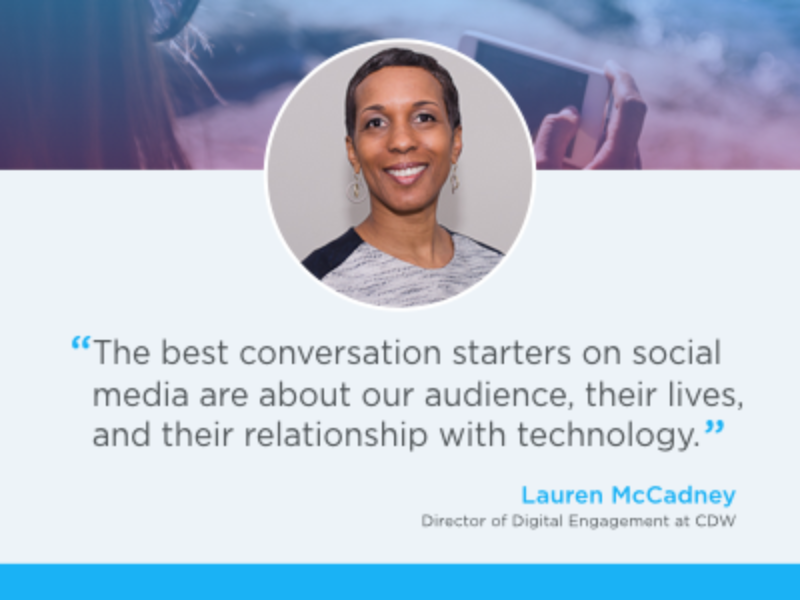Most of us have never heard of System Administrator Appreciation Day (#SysAdminDay), an annual event to recognize the people who keep office computer systems running. But for those who purchase IT solutions, it’s an important occasion. That’s why Lauren McCadney, director of digital engagement at CDW, used #SysAdminDay as a springboard for a Twitter campaign.
“The best conversation starters on social media are about our audience, their lives, and their relationship with technology,” McCadney explained.

We spoke with McCadney, who has led marketing efforts at CDW for more than a decade, to learn more about how the tech B2B brand uses Twitter to connect with customers, drive relevant traffic to its website, and collect insights that help inform its larger communications and content strategies.
@TwitterAds: When did you first realize that Twitter could be an effective marketing channel?
@CDWCorp: My first impression of Twitter was that it created an easy way to cultivate the world around you, without having to search or research. Twitter is a shortcut to the really important information in your life.
Then the lightbulb went on. I realized that brands could be successful by engaging users in a respectful manner, and with an eye towards “why is this content valuable to the person on the other end of the keystroke?”.
@TwitterAds: How do you engage the customers on the other end of your keystrokes?
@CDWCorp: There are four tricks. First, we closely monitor what works on each social platform. We’ve known from our early days that what takes off like wildfire on Twitter may not get a spark on another platform.
Second, we put our audience first, and develop content that’s super relevant to them. We know that geek humor works for our customers. Through listening and closely monitoring content performance, our conversation calendar is geared toward topics that we know are relevant and timely.
Third, we recognize that social media is a visual world. To cut through the clutter, you need a clever idea and a visual that brings it to life.
See how APC can help you stay powered all the way through overtime in our newest spot. http://t.co/gvYMfL1Saq https://t.co/WssPE0JYPf
— CDW Corporation ( @CDWCorp) March 23, 2015
Finally, we take opportunities to ask people about topics they care about, such as IT survival hacks.
@TwitterAds: We know you also use Twitter to get more mileage out of events. Can you give us an example?
@CDWCorp: We decided to make the most of #SysAdminDay by creating an eight-part video series to share a day in the life of a SysAdmin. Each video covered an hour of a system administrator’s typical day. We incentivized Twitter users to share the videos by offering them a chance to win a cool tech prize if they did so. This helped us to gain incremental reach.
We’re celebrating #SysAdminDay early! See how and win great prizes from Microsoft & Logitech: http://t.co/dfykUczCdn https://t.co/Vk0XqQVKnL
— CDW Corporation ( @CDWCorp) July 22, 2015
The campaign drove outstanding website traffic and engagement. On average, site visitors referred from Twitter spent five minutes on our landing page, which was a clear signal they had watched more than one of our videos. Customers also used Twitter to tell us how much they loved our content, which was great feedback that we were reaching the right audience.
CDW was spot on with these videos! Great job! #sysadminday #CDW https://t.co/WmwbG86drl
— Kelly Hicks ( @khicks2832) July 31, 2015
@TwitterAds: Has anything surprised you about your Twitter results?
@CDWCorp: A year ago, Twitter rolled out audience insights, a tool that allowed us to see the demographics and interests of the people who engage with our Tweets. I look for convergence of data, so when I saw the right conversion behaviors on our site coupled with the audience insight reports about who my Twitter followers were, it was a pleasant reinforcement that we were getting it right.
@TwitterAds: What should B2B brands know about using Twitter?
@CDWCorp: Content distribution and engagement can be a challenge for B2B brands. Sometimes we get so wrapped up in creating videos and blog posts that we forget that our work is not done when the director yells “cut” or when we add the period at the end of a sentence.
Our job is done when this content is consumed, and when we hear that it was helpful, sparked thought, or that our customer found the information so beneficial that they share it with someone else. Twitter helps us make sure we’re getting eyes on what we’re producing, and gives us feedback on our content that helps inform our advertising and communications strategies.
For more information about how tech brands use Twitter, check out these success stories.
Did someone say … cookies?
X and its partners use cookies to provide you with a better, safer and
faster service and to support our business. Some cookies are necessary to use
our services, improve our services, and make sure they work properly.
Show more about your choices.